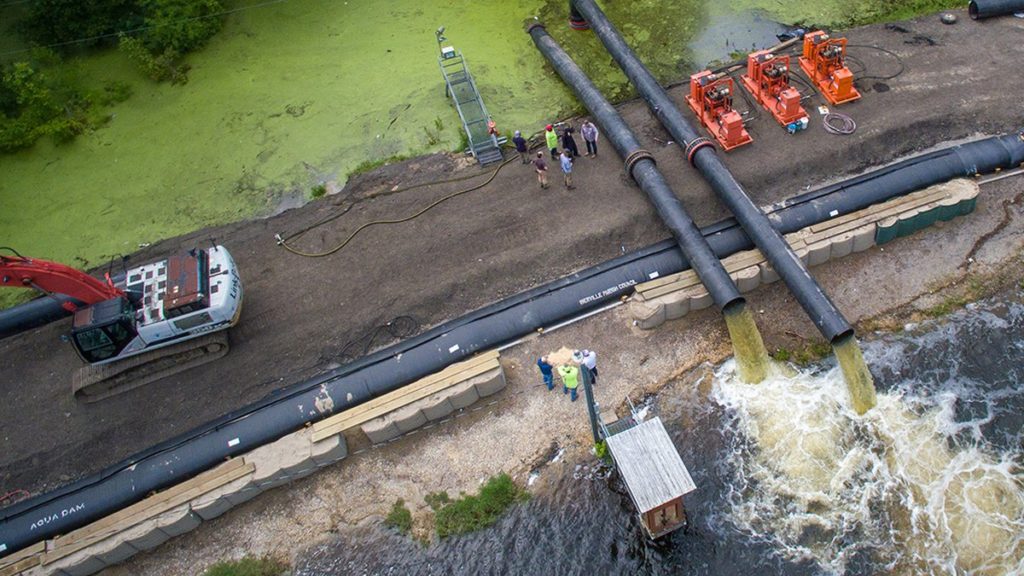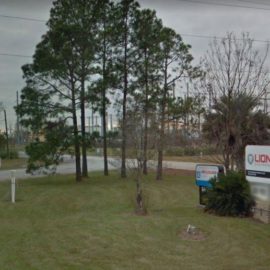
1983 is 40 years ago and protections are still not completed. 40 years is too long!
Contractors recently poured concrete for new floodgates that are supposed to help protect homes in Ascension Parish’s Bluff Swamp, culminating more than a decade of discussion, design, permitting and land purchasing. But the new $3.5 million floodgates at Fish Bayou being built by parish government and the Pontchartrain Levee District are only a partial answer to the chronic and, residents say, worsening flooding in the greater Spanish Lake area. For Christy Hames, who grew up in the Ridge Road area of the Bluff Swamp and raised her five children there, the partial measure isn’t enough to give her peace of mind. Hames, who’s in her late 40s, said she’s not willing to risk coming back from a flood for a third time since 2016 waiting on bigger-picture flood protection plans to become a reality. So, the for-sale sign is up. “That’s how much faith I have in Ascension Parish right now,” she said in a recent interview on her front porch, referring to the sign along the road. “That’s how much faith I have in Ascension Parish to make sure we never flood again.”
They cry when people move but if you are always flooding out why not? They alsoi winder why New Orleans gt an increase and look at what Ida did and the lack of flooding and you see why.
Hames and others who decide to move away from low-lying areas and not wait on the promises of the future flood protection are, in a sense, victims of the long timeframes that governments traditionally need to find, fund and build major infrastructure. Though Hames’ skepticism is focused on Ascension government, the parish is hardly alone in trudging through generationally long lead times to see big drainage projects become a reality. Each of them, in each parish, has its own story of limbo or delay: the West Shore Levee in the river parishes, bayou clearing in Baton Rouge, dredging the Amite and Comite rivers, the Darlington Dam, completion of a levee system around eastern Ascension and a variety of ideas to pump flood water to the Mississippi River.
theadvocate.com
These are long running projects that did not need to be this long.
The Fish Bayou floodgates are one of three long-running projects that Ascension has gotten off the ground or is close to starting after a decade or decades of political, regulatory and legal wrangling. The others include the dredging of New River Canal, a major artery for the parish’s east bank drainage pump station, and the Laurel Ridge Levee extension, a controversial piece that will plug a hole in the parish’s eastern flood wall along the Amite River. Rick Geddes, an economist and director of Cornell University’s program on infrastructure policy in Ithaca, New York, said that while Louisiana may face unique challenges, the problems in the timely and cost-effective delivery of new infrastructure occur across the nation. Geddes noted he has his students read news coverage from a few years ago about a New York subway line that cost $3.5 billion per mile to build — the most expensive in the world at the time. “The (news) article was asking the question, ‘Why, right? You know, why is this U.S. infrastructure so slow and expensive to deliver?’ And the answer is there’s not one factor, right? There’re several factors at work,” he said.
The factors re nation wide which does not speak well to contractors nationwide.
Geddes and a handful of local officials suggested all or some of three factors are often at play in slowing things down: winning the money, getting the permits and land, and finding a political consensus backed with a sense of urgency. In an unpublished statistical analysis, for instance, Geddes found that federal agencies took nearly five years, on average, between 2010 and 2018 to complete the most detailed reviews under the National Environmental Policy Act. Usually reserved for largest or most impactful projects, these reviews are known as environmental impact statements. NEPA was adopted in 1970 as a corrective to heavy-handed federal public works decisions, to better protect the environment and cultural and archaeological resources and to account for public concerns. The law has been hailed by environmentalists as a touchstone that has avoided poorly thought-out and needlessly destructive projects. The Laurel Ridge levee in Ascension, for example, drew opposition from several quarters during permitting, had to be reconfigured to avoid wetlands and will need long-term hydrological monitoring for the hundreds of acres of wetlands that will be caught behind the future earthen wall, U.S. Army Corps of Engineers officials said. The Darlington Dam, a $2.3 billion structure that would temporarily hold back Amite River flood waters across thousands of acres in St. Helena and East Feliciana parishes, has encountered stiff opposition. The proposal has been waiting more than a year on Corps headquarters’ authorization to spend more money and time analyzing whether the soils under the 86-foot-tall structure would be strong enough to keep it from failing catastrophically.
So not just the contractors but the people who don’t want it and if they go to court that adds years.
But NEPA has also become a lightning rod for the business community and conservative policymakers as a deterrent to needed progressGeddes, a non-resident scholar at the conservative American Enterprise Institute, said that while some in Congress have proposed reforms to speed up the NEPA process, no “silver bullet” exists fix to the overall problem with infrastructure.. Layton Ricks, the three-term president of Livingston Parish, said he’s had to learn that government works on its own timeline and requires steps that you wouldn’t take in the private sector. “I just … I can honestly look at you from across the table and say, ‘I just don’t get it,'” Ricks said. “I guess I think simple. I think just, ‘Let’s just get it done,’ but the world we live in government, it just doesn’t happen overnight.”
The work in Ascension Parish followed to the sentence all three ways a project could be delayed.
For years before the Fish Bayou floodgate construction began, Ascension, levee district and other local officials had grappled with managing the water in the greater Spanish Lake basin as continued population growth sent more runoff its way. Sometimes in conflict with one another, government officials and landowners had a high-profile spat in the late 2000s when Iberville Parish reasserted its control over key floodgates at Alligator Bayou and prompted a battle with then-swamp tour operator and landowner Frank Bonifay over water levels in the basin. For years afterward, proposals to reach a global fix of the basin’s water management went nowhere and occasional dustups among the parishes emerged, as when Iberville installed portable dams along Bayou Manchac and drew lawsuits from East Baton Rouge Parish. In Ascension and Iberville, parish officials focused for a time on what they could control, expanding the ability of the parishes’ existing floodgates or building new ones to drain the basin into Bayou Manchac. Three-term Ascension Councilwoman Teri Casso — who has faced criticism over flooding in the Ridge Road area and recently survived a recall attempt — for years made it a practice to ask administration officials about the status on expanded floodgates for the Bluff Swamp in monthly drainage meetings. But even the partial measure of floodgates took years to decide on the right location and to permit through the Corps of Engineers. Casso said the experience of ’16 flood led parish officials to alter their plans and restart permitting, shifting from expanding existing floodgates at Frog Bayou to building entirely new, large gates nearby at Fish Bayou. A change in administration and a pandemic slowed things some too as new officials got up to speed. “Any project is a long project. You know, I wish that weren’t true, but I’ve been doing this 11 years and I haven’t seen one done quickly yet,” Casso said.
While the people have dithered the weather has not.
But the series of floods and hurricanes over the past several years has created a once-in-a-generation opportunity to do big, impactful projects as billions of dollars have been sent to Louisiana. The prospect of money has also created opportunities for greater cooperation. U.S. Rep. Garret Graves, R-Baton Rouge, said his office helped referee meetings among local officials to work through projects that have multi-parish impact and posed what he called the “flooding Peter to keep Paul dry” problem. “So, what we’ve done on those, is we’ve sat everybody down and we’ve said, ‘Hey, look, we don’t have any desire to flood you just to keep you dry. We want to figure out how we think through this and keep everybody dry. How do we move forward in the greater good,'” Graves said. Part of the $1.2 billion in Louisiana Watershed Initiative money and other dollars that Graves helped bring to the state has eased the path to solutions.
A number of projects benefited from this intense work.
The “five bayous” project in Baton Rouge, a Corps of Engineers plan dating from the 1990s to clear key waterways, is now fully funded. The city-parish is using additional watershed dollars to build flood retention areas to lessen the downstream impact of that work, which had worried neighboring parishes. The Laurel Ridge Levee, blocked for a few years over litigation with Livingston Parish, is closing in on a construction start after watershed money was directed to a companion project to dig channels under La. 22 and route flood water under the highway, minimizing the impact of the levee on Livingston. For Spanish Lake, local officials are eyeing watershed dollars to do a costly and complicated replumbing of the Bluff Swamp, Spanish Lake and New River Canal watersheds so they drain against their natural flow to new pump stations at the Mississippi. The plan could take a decade or more and will need significant permitting review. Graves said that as long as he is in office, he would continue to try referee these kinds of disputes but acknowledged a more formal, longer term answer may be necessary. Some local legislators are talking about better empowering the Amite River Basin Commission to be a regional flood control authority after a report from the Coastal Protection and Restoration Authority recommended as much. State Rep. Buddy Mincey Jr., R-Denham Springs, has filed H.B. 686 for the coming legislative session to do so.
There are still problems and still ways the projects will be stymied.
But, even with all the money in the bank, permitting done and several phases of construction happening at the same time to speed things along, delays happen. The Comite River Diversion Canal in the Zachary area is perhaps the Baton Rouge region’s best-known and long-running public project. The flood protection canal got its first major push after the 1983 flood and garnered new momentum and, finally, saw its chronic funding problems solved after the 2016 flood. A few weeks after the ’16 flood, a top Corps official estimated that if the agency did have all the money that it needed upfront and the diversion could proceed “in a perfect world,” the 12-mile canal to the Mississippi could be done in two years. This past week, Corps officials announced that the canal’s construction, which began in spring 2019, won’t be completed by the end of 2022 as hoped, missing a second deadline to finish the job and pushing the project toward its fourth year of construction. Delays in the negotiation of a critical pipeline relocation and, earlier, railroad bridge construction and land acquisition have conspired to slow progress, officials said.
There are major national and state agencies that re involved and they have to work together.
Corps officials said they can’t say yet how much longer the work will take. They are waiting to hear what state highway officials negotiated with a pipeline company, Florida Gas, to relocate its line and how those agreements will affect the timing of the final phases of the canal’s construction. Highway officials are expected to reveal their plans Thursday in a legislative task force meeting on the diversion. “Based on what we know right now,” Corps of Engineers in New Orleans spokesman Ricky Boyett said, “we know we will not be completed by December 2022.”
Eventually they will be done – but when?



